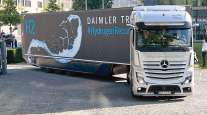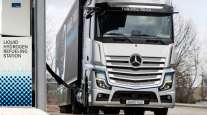Daimler Offers New Powertrain Leveraging Detroit Integration
This story appears in the May 26 print edition of Transport Topics.
DETROIT — Daimler Trucks North America unveiled a new Detroit-brand powertrain package here, providing greater vehicle-component integration and a series of new technologies to offer what company officials called their most fuel-efficient package yet.
The powertrain from the Detroit Diesel Corp. division includes the DD15 engine; the DT12 automated manual transmission and new axle offerings. It will be available on the Freightliner Cascadia Evolution in January and later in 2015 for the soon-to-be-offered Western Star 5700.
“If customers are looking for optimal fuel efficiency, this is the vehicle,” said David Hames, DTNA’s general manager of marketing and strategy.
He said the powertrain can increase fuel economy an additional 5% to 7% above the current model Evolution. During 2012, the company said it had achieved greater than nine miles per gallon during road trials.
At a May 22 press briefing at DDC headquarters, company officials said the powertrain package is partially in response to a changing customer base.
Hames said customers often view themselves first as business owners, who are not as likely as previous generations to be able to keep up with every technological development on today’s increasingly sophisticated trucks.
“Customers say they want an 8 mpg truck and ask, ‘What is the solution,’ ” he said. “They are looking for the best tool and solution” rather than specifying each component themselves.
Hames and Brad Williamson, manager of engine and component marketing for DTNA, said the Detroit integration efforts provide greater opportunities for such advancements that cannot be duplicated when using outside suppliers.
Proprietary information and strategy sessions with other companies can be “touchy for engineers” and create a performance ceiling for the powertrain, they said.
But this larger powertrain integration allows for open sharing of data that will clearly provide fleet customers better truck performance, they said.
Part of the new package involves incremental improvement in existing Detroit components, but there is also a greater emphasis on the DT12. The company had used the Eaton Corp. UltraShift Plus AMT on earlier Cascadia Evolutions.
Eaton and engine maker Cummins Inc. have been fighting back against DTNA and Volvo Group on the issue of vertical integration by offering a Cummins-Eaton harmonized engine-transmission package for truck makers.
Detroit managers said the DT12 transmission uses “intelligent powertrain management.” The new technology includes pre-loaded terrain maps and GPS to know the route ahead and automatically adjust transmission and engine operation.
“Intelligent Powertrain Management makes sure the truck is carrying the most efficient momentum into the road ahead,” said Williamson.
Detroit also said the new DD15 engine offers a new down-speed rating of 400 horsepower and 1,750 pound-feet of torque as an operating sweet spot. The down-speeding allows the engine to work at lower rpm, regardless of vehicle speed, reducing fuel consumption.
This is Detroit’s first move into down-speeding, Hames said, which can reduce the cruising speed and provide a fuel-economy gain as rpm drop.
In addition, the company is offering its first 6x2 axle configuration with a 2.28 ratio. That is the fastest ratio, meaning a lower ratio number, available in Freightliner and Western Star trucks, and is designed to work with the new engine rating. The configuration reduces weight by almost 400 pounds, Daimler said, while a new 2.41 ratio in the 6x4 configuration also is available for greater traction.
A 6x2 arrangement supplies power to two of the tractor’s six wheel positions, whereas power goes to four positions in a 6x4. The weight savings come from having one differential in a 6x2 instead of two differentials in a 6x4.
Hames said the 6x2 “is not widespread, but is where we are going,” and “there will be continued acceptance within many trucking applications because of the fuel-economy gains.”
At the briefing, company managers also previewed an application for tablets that will roll out in June and outline the benefits of the new powertrain and simplify the ordering process.
“This piece alone is a huge step for our company, dealers and customers,” Williamson said.
DTNA said last year it would offer Detroit Connect, the first factory-installed computer tablet for its trucks and a new communications package to provide services over that tablet.




